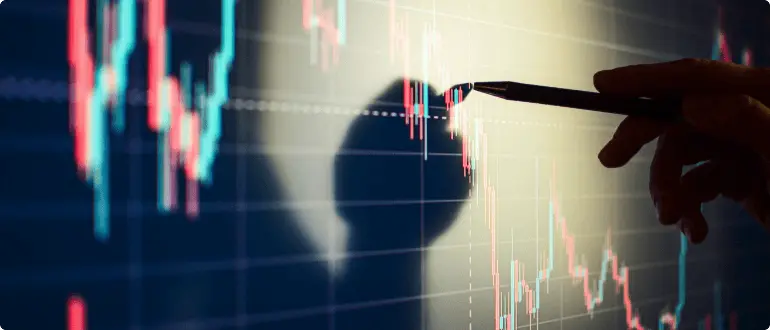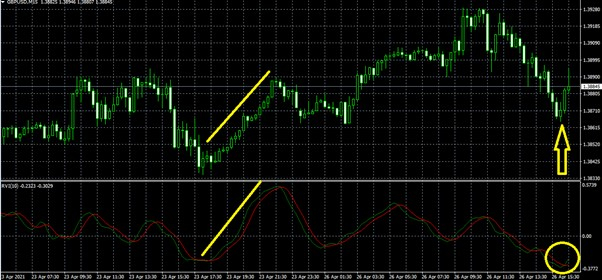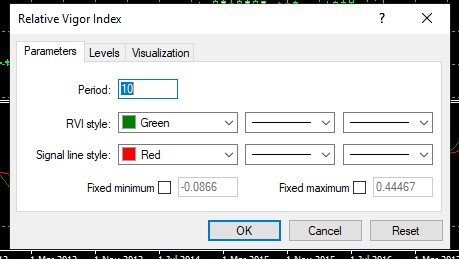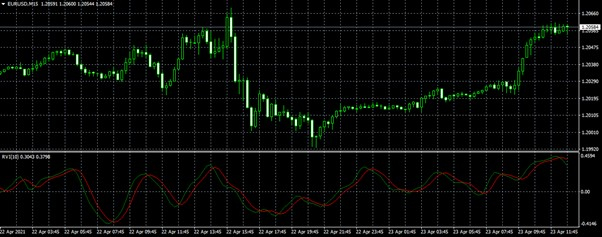Relative Vigor Index: what is this Forex indicator | FxPro

Table of Contents
- What is the relative vigor index indicator?
- Relative Vigor Index Calculation
- How to use the RVI Indicator
- Using the RVI Indicator in MetaTrader 4 & other FxPro Platforms
- Relative vigor index strategy
- Using in conjunction with other indicators
- RVI in Conclusion
The Relative Vigor Index Indicator (RVI) is a leading momentum oscillator indicator that uses smoothed moving averages to help gauge the direction and strength of trends in the short or medium term. Donald Dorsey developed the indicator in the ‘90s, and it is now widely used and available as default on most trading platforms.
In this article, we will explain the logic behind the relative vigor indicator, how it is calculated and how you can utilise it within in your trading strategy.
What is the relative vigor index indicator?
The VRI methodology is based on the observation that during an uptrend, the close price is higher than the open, and in a downtrend, the close price is lower than the open. It essentially determines bullish and bearish sentiment by comparing the closing prices to the trading range of the instrument for a specific period.
‘Vigor’ refers to the strength or healthiness of the trend, which can be analysed by determining where the price ends up closing. The indicator is comprised of 2 lines: the signal line and the RVI line.
Being an oscillator, the indicator will appear in a separate window below the price chart rather than being overlayed on top of chart prices.
The relative vigor index is very similar to the Stochastic indicator, except stochastic compares close prices to the low, rather than the open.
Relative Vigor Index Calculation
The relative vigor index calculation is relatively simple:
RVI Line (Green)=(CLOSE-OPEN)/(HIGH-LOW) for the time period (usually 10)
Signal line (Red) weighted SMA set over 4 periods
There is also a dotted horizontal line with the value of 0, by which the RVI and signal lines move around in waves.
Here is an example of how the relative vigor index indicator appears. You will notice it oscillates positively or negatively around a centerline value of 0.

How to use the RVI Indicator
When the sentiment is bullish, you can expect the RVI indicator to rise, whereas a falling RVI suggests momentum is falling. As a leading indicator, it will move slightly ahead of price action.
- If the relative vigor index diverges from the price movements, it suggests an imminent change in the trend. So if the instrument price is falling whilst the RVI is rising, it indicates that in the near term, the price may reverse in an upwards direction.
- High values suggest the instrument may be overbought, producing a sell signal, while a low value suggests it may be oversold, issuing a buy signal.
- A crossover between the two lines indicates future price direction. The crossing of the RVI above the signal line suggests a bullish trend, while a cross below the signal line suggests a bearish trend.
- You can also look for candlestick patterns mirrored in the relative vigor index indicator, strengthening their relevance.
Here is the RVI indicator applied to a 15-minute forex chart.

The yellow trend lines show how the RVI gave us an uptrend signal when the green line crossed over the red line in an upwards direction. Its occurrence at a very low RVI indicated that the trend would be strong. In the yellow circle, we can see a new signal forming at an even lower reading than the previous, suggesting a new uptrend with even stronger momentum. As you can see, the price chart did change direction upon the indicators signal.
Using the RVI Indicator in MetaTrader 4 & other FxPro Platforms
The RVI indicator is available as standard in the MT4, MT5, cTrader & FxPro native platforms.
In MT4, simply drag and drop the indicator onto the chart from the ‘oscillator’ folder under indicators in the navigator window. You can edit the colours and period according to your preferences; however, the suggested period value is 10. The period represents the number of bars used in the calculation. I.e. on a daily chart, it represents 10 days.

Relative vigor index strategy
The ideal strategy is to use the RVI to get gain maximum profits during a long term trend.
Here is how the RVI indicator looks applied to the EURUSD 15minute chart:

You will notice that when the green line crosses below the red, the price chart follows in a downwards direction, and when the green line crosses above the red line, prices move in an upwards direction, or the current trend stops.
The values of the indicator may be above or below the 0 baseline, a buy signal occurs when the RVI indicator is below 0, and the green line moves above the red. Similarly, when lines are above the value of 0, and the green lines moves below the red, this is a sell signal.
You can also use the crossovers as a guide to exit trades.
However, as you can see, crossovers don’t always lead to a new trend or a reversal, so it is important to analyse and develop your own strategy for strengthening and confirming signals.
The indicator was originally created to work on the daily close price of stocks, but this doesn’t mean you can only use only on the daily chart. It can be applied to any time frame or instrument, including forex.
Using in conjunction with other indicators
One limitation of the RVI indicator is that it works best in trending markets, and therefore will lead to false signals when used in ranging markets. Because it’s a leading indicator, it may give signals contrary to current price values, which may confuse you.
This is why it is better to confirm signals using other indicators or technical analysis.
In ranging markets, the Stochastic & RSI indicators can be used, but they are very similar to the RVI and may not be very helpful in confirming signals.
One of the simplest but most effective methods is to use 2 Moving Averages on the price chart in conjunction with the relative vigor index. Using a fast (lower period) and slow (longer period) MA can give confirmation signals when the fast one crosses the slow one either in an upwards direction (uptrend) or a downwards direction (downtrend).
For example, here, you can see the RVI indicator giving a buy signal, but rather than acting on it right away, we can wait for later confirmation of the move when the red (faster) MA crosses above the blue (slower) one:

RVI in Conclusion
Whilst the calculation behind the RVI indicator is relatively simple, signals can be hard to interpret if you are new to the indicator or trading in general. This is why we suggest practising with it in a demo environment and complementing it with other indicators or tech analysis.




